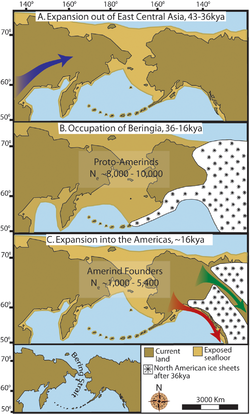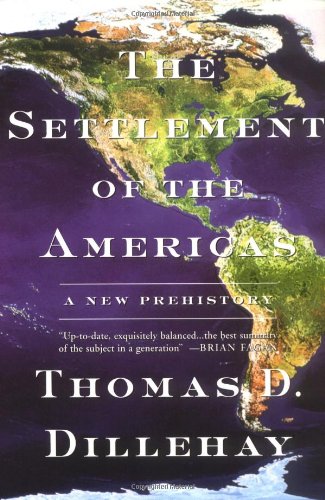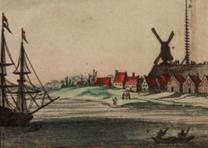The question of how, when, where and why humans first entered the Americas is of intense interest to archaeologists and anthropologists, and has been a subject of heated debate for centuries. Several models for the Paleo-Indian settlement of the Americas have been proposed by various academic communities. Modern biochemical techniques, as well as more thorough archaeology, have shed progressively more light on the subject.
Current understanding of human migration to and throughout the Americas derives from advances in four interrelated disciplines: linguistics, archeology, physical anthropology, and DNA analysis. While there is general agreement that the Americas was first settled from Asia by people who migrated across Beringia, the pattern of migration, its timing, and the place of origin in Asia of the peoples who migrated to the Americas remains unclear. In recent years, researchers have sought to use familiar tools to validate or reject established theories, such as Clovis first. As new discoveries come to light, past hypotheses are reevaluated and new theories constructed. The archeological evidence suggests that the Paleo-Indians' first "widespread" habitation of the Americas occurred during the end of the last glacial period or, more specifically, what is known as the late glacial maximum, around 16,500â€"13,000 years ago.
Understanding the debate

In the early 21st century, the chronology of migration models is divided into two general approaches. The first is the short chronology theory, based on the concept that the first movement beyond Alaska into the New World occurring no earlier than 15,000â€"17,000 years ago, followed by successive waves of immigrants. The second belief is the long chronology theory, which proposes that the first group of people entered the Americas at a much earlier date, possibly 21,000â€"40,000 years ago, with a much later mass secondary wave of immigrants.
One factor fueling the debate is the discontinuity of archaeological evidence between North and South American Paleo-Indian sites. A roughly uniform techno-complex pattern, known as Clovis, appears in North and Central American sites from at least 13,500 years ago onwards. South American sites of equal antiquity do not share the same consistency and exhibit more diverse cultural patterns. Archaeologists conclude that the "Clovis-first", and Paleo-Indian time frame do not adequately explain complex lithic stage tools appearing in South America. Some theorists seek to develop a migration model that integrates both North and South American archaeological records.
Indigenous Amerindian genetic studies indicate that the "colonizing founders" of the Americas emerged from a single-source ancestral population that evolved in isolation, likely in Beringia. Age estimates based on Y-chromosome micro-satellite place diversity of the American Haplogroup Q1a3a (Y-DNA) at around 10,000 to 15,000 years ago. This does not address if there were any previous failed colonization attempts by other genetic groups, as genetic testing can only address the current population's ancestral heritage.
Migrants from northeastern Asia could have walked to Alaska with relative ease when Beringia was above sea level. But traveling south from Alaska to the rest of North America may have posed significant challenges. The two main possible southward routes proposed for human migration are: down the Pacific coast; or by way of an interior passage (Mackenzie Corridor) along the eastern flank of the Rocky Mountains. When the Laurentide and Cordilleran ice sheets were at their maximum extent, both routes were likely impassable. The Cordilleran sheet reached across to the Pacific shore in the west, and its eastern edge abutted the Laurentide, near the present border between British Columbia and Alberta.
Geological evidence suggests that the Pacific coastal route was open for overland travel before 23,000 years ago and after 15,000 years ago. During the coldest millennia of the last ice age, roughly 23,000 to 19,000 years ago, lobes of glaciers hundreds of kilometers wide flowed down to the sea. Deep crevasses scarred their surfaces, making travel across them dangerous. Even if people traveled by boatâ€"a claim for which there is no direct archaeological evidence, as sea level rise has hidden the old coastlineâ€"the journey would have been difficult due to abundant icebergs in the water. Around 15,000 to 13,000 years ago, the coast is presumed to have been ice-free. Additionally, by this time the climate had warmed, and lands were covered in grass and trees. Early Paleo-Indian groups could have readily replenished their food supplies, repaired clothing and tents, and replaced broken or lost tools.
Coastal or "watercraft" theories have broad implications, one being that Paleo-Indians in North America may not have been purely terrestrial big-game hunters, but instead were already adapted to maritime or semi-maritime lifestyles. Additionally, it is possible that "Beringian" (western Alaskan) groups migrated into the northern interior and coastlines only to meet their demise during the last glacial maximum, approximately 20,000 years ago, leaving evidence of occupation in specific localized areas. However, they would not be considered a founding population unless they had managed to migrate south, populate and survive the coldest part of the last ice age.
Timeline of selected archaeological, geological and genetic evidence
Genetics and blood type

By the 1920s studies indicated that blood type O was predominant in pre-Columbian populations, with a small admixture of type A in the north. Further blood studies combining statistics and genetic research were pioneered by Luigi Cavalli-Sforza and applied to population migrations predating historical records. This led Jacob Bronowski to assert in 1973 (in The Ascent of Man) that there were at least two separate migrations:
"I can see no sensible way of interpreting that but to believe that a first migration of a small, related kinship group (all of blood group O) came into America, multiplied, and spread right to the South. Then a second migration, again of small groups, this time containing either A alone or both A and O, followed them only as far as North America."
Modern Amerindian genetics studies focus primarily on human Y-chromosome DNA haplogroups (yDNA haplogroups) and human mitochondrial DNA haplogroups (mtDNA haplogroups). The genetic pattern emerging shows two very distinctive genetic episodes occurred, first with the initial peopling of the Americas, and secondly with European colonization of the Americas. The former is the determinant factor for the number of gene lineages, zygosity mutations and founding haplotypes present in today's indigenous Amerindian populations.
Genetics and blood studies indicate human settlement of the New World occurred in stages from the Bering sea coastline, with an initial layover on Beringia for the small founding population. The micro-satellite diversity and distributions of the Y lineage specific to South America indicates that certain Amerindian populations have been isolated since the initial colonization of the region. The Na-Dené, Inuit and Indigenous Alaskan populations exhibit haplogroup Q (Y-DNA) mutations, but are distinct from other indigenous Amerindians with various mtDNA and autosomal DNA (atDNA) mutations. This suggests that the earliest migrants into the northern extremes of North America and Greenland derived from later migrant populations.
Land bridge theory

Also known as the Bering Strait Theory or Beringia theory, the Land Bridge theory has been widely accepted since the 1930s. The idea was first postulated in a rudimentary fashion in 1590 by the Jesuit scholar José de Acosta. This model of migration into the New World proposes that people migrated from Siberia into Alaska, tracking big game animal herds. They were able to cross between the two continents by a land bridge called the Bering Land Bridge, which spanned what is now the Bering Strait, during the Wisconsin glaciation, the last major stage of the Pleistocene beginning 50,000 years ago and ending some 10,000 years ago, when ocean levels were 60 metres (200 ft) lower than today. This information is gathered using oxygen isotope records from deep-sea cores. An exposed land bridge that was at least 1,000 miles (1,600 km) wide existed between Siberia and the western coast of Alaska. In the "short chronology" version, from the archaeological evidence gathered, it was concluded that this culture of big game hunters crossed the Bering Strait at least 12,000 years ago and could have eventually reached the southern tip of South America by 11,000 years ago.
Crossings by foot of the Bering Sea, however, are also possible when the sea is frozen.
Synopsis
At some point during the last Ice Age, about 17,000 years ago, as the ice sheets advanced and sea levels fell, people first migrated from the Eurasian landmass to the Americas. These nomadic hunters were following game herds from Siberia across what is, today the Bering Strait into Alaska, and then gradually spread southward. Based upon the distribution of Amerind languages and language families, a movement of tribes along the Rocky Mountain foothills and eastward across the Great Plains to the Atlantic seaboard is assumed to have occurred at least some 13,000 to 10,000 years ago.
Clovis culture
This big game-hunting culture has been labeled the Clovis culture, and is primarily identified by its artifacts of fluted projectile points. The culture received its name from artifacts found near Clovis, New Mexico, the first evidence of this tool complex, excavated in 1932. The Clovis culture ranged over much of North America and appeared in South America. The culture is identified by a distinctive Clovis point, a flaked flint spear-point with a notched flute by which it was inserted into a shaft. It could be removed from the shaft for traveling. This flute is one characteristic that defines the Clovis point complex.
Dating Clovis materials has been by association with animal bones and by carbon dating. Recent reexaminations of Clovis materials using improved carbon-dating methods produced results of 11,050 and 10,800 radiocarbon years B.P. (before present). This evidence suggests that the culture flowered somewhat later and for a shorter period of time than previously believed. Michael R. Waters of Texas A&M University in College Station and Thomas W. Stafford Jr., proprietor of a private-sector laboratory in Lafayette, Colorado and an expert in radiocarbon dating, attempted to determine the dates of the Clovis period. The heyday of Clovis technology has typically been set between 11,500 and 10,900 radiocarbon years B.P. (The radiocarbon calibration is disputed for this period, but the widely used IntCal04 calibration puts the dates at 13,300 to 12,800 calendar years B.P.). In a controversial move, Waters and Stafford conclude that no fewer than 11 of the 22 Clovis sites with radiocarbon dates are "problematic" and should be disregardedâ€"including the type site in Clovis, New Mexico. They argue that the datable samples could have been contaminated by earlier material. This contention was considered highly controversial by many in the archaeological community.
In 2014, the autosomal DNA of a 12,500+-year-old infant from Montana was sequenced. The DNA was taken from a skeleton referred to as Anzick-1, found in close association with several Clovis artifacts. Comparisons showed strong affinities with DNA from Siberian sites, and virtually ruled out any close affinity with European sources (the so-called "Solutrean hypothesis"). The DNA also showed strong affinities with all existing Native American populations, which indicated that all of them derive from an ancient population that lived in or near Siberia, the Upper Palaeolithic Mal'ta population. The data indicate that Anzick-1 is from a population directly ancestral to present South American and Central American Native American populations, ruling out hypotheses which posit that invasions subsequent to the Clovis culture overwhelmed or assimilated previous migrants into the Americas. Anzick-1 is less closely related to present North American Native American populations, suggesting an early divergence between North American and Central plus South American populations, with the North American populations being basal to the rest.
Problems with Clovis migration models
Significant problems arise with the Clovis migration model. If Clovis people radiated south after entering the New World and eventually reached the southern tip of South America by 11,000 years ago, this leaves only a short time span to populate the entire hemisphere. Another complication for the Clovis-only theory arose in 1997, when a panel of authorities inspected the Monte Verde site in Chile. They concluded that the radiocarbon evidence predates Clovis sites in the North American Midwest by at least 1,000 years. This supports the theory of a primary coastal migration route people used to move south along the coastline faster than those who migrated inland into the central areas of the Americas. Many excavations have uncovered evidence that subsistence patterns of early Americans included foods such as turtles, shellfish, and tubers. This is a change of diet from the big game mammoths, long-horn bison, horse, and camels that early Clovis hunters apparently followed east into the New World.
At the Topper archaeological site (located along the banks of the Savannah River near Allendale, South Carolina) investigated by University of South Carolina archaeologist Dr. Albert Goodyear, charcoal material recovered in association with purported human artifacts returned radiocarbon dates of up to 50,000 years before the present (BP). This would indicate the presence of humans well before the last glacial period. Considerable doubt over the validity of these findings has been raised by many other researchers, and the pre-Clovis Topper dates remain controversial. Charcoal could have originated from forest fires, and the crude stone artifacts may be misinterpreted geofacts.
Pre-Clovis dates have been claimed for several sites in South America, but these early dates have not been verified unequivocally.
Discoveries in 2002 and 2003 of human coprolites (fossilized feces) as well as hunting tools found deeply buried in the Paisley Caves in Oregon indicate the presence of humans in North America as much as 1,200 years prior to the Clovis culture.
Watercraft migration theories

Earlier finds have led to a pre-Clovis culture theory encompassing different migration models with an expanded chronology to supersede the "Clovis-first" theory.
Pacific coastal models
Pacific models propose that people first reached the Americas via water travel, following coastlines from northeast Asia into the Americas. Coastlines are unusually productive environments because they provide humans with access to a diverse array of plants and animals from both terrestrial and marine ecosystems. While not exclusive of land-based migrations, the Pacific 'coastal migration theory' helps explain how early colonists reached areas extremely distant from the Bering Strait region, including sites such as Monte Verde in southern Chile and Taima-Taima in western Venezuela. Two cultural components were discovered at Monte Verde near the Pacific Coast of Chile. The youngest layer is radiocarbon dated at 12,500 radiocarbon years (~14,000 cal BP) and has produced the remains of several types of seaweeds collected from coastal habitats. The older and more controversial component may date back as far as 33,000 years, but few scholars currently accept this very early component.
Other coastal models, dealing specifically with the peopling of the Pacific Northwest and California coasts, have been advocated by archaeologists Knut Fladmark, Roy Carlson, James Dixon, Jon Erlandson, Ruth Gruhn, and Daryl Fedje. In a 2007 article in the Journal of Island and Coastal Archaeology, Erlandson and his colleagues proposed a corollary to the coastal migration theoryâ€"the "kelp highway hypothesis"â€"arguing that productive kelp forests supporting similar suites of plants and animals would have existed near the end of the Pleistocene around much of the Pacific Rim from Japan to Beringia, the Pacific Northwest, and California, as well as the Andean Coast of South America. Once the coastlines of Alaska and British Columbia had deglaciated about 16,000 years ago, these kelp forest (along with estuarine, mangrove, and coral reef) habitats would have provided an ecologically similar migration corridor, entirely at sea level, and essentially unobstructed.
East Asians: Paleoindians of the coast
The boat-builders from Southeast Asia may have been one of the earliest groups to reach the shores of North America. One theory suggests people in boats followed the coastline from the Kurile Islands to Alaska down the coasts of North and South America as far as Chile [2 62; 7 54, 57]. The Haida nation on the Queen Charlotte Islands off the coast of British Columbia may have originated from these early Asian mariners between 25,000 and 12,000. Early watercraft migration would also explain the habitation of coastal sites in South America such as Pikimachay Cave in Peru by 20,000 years ago and Monte Verde in Chile by 13,000 years ago [6 30; 8 383].
- "'There was boat use in Japan 20,000 years ago,' says Jon Erlandson, a University of Oregon anthropologist. 'The Kurile Islands (north of Japan) are like stepping stones to Beringia,' the then continuous land bridging the Bering Strait. Migrants, he said, could have then skirted the tidewater glaciers in Canada right on down the coast." [7 64]'
Atlantic coastal model
Archaeologists Dennis Stanford and Bruce Bradley champion the coastal Atlantic route. Their Solutrean Hypothesis is also based on evidence from the Clovis complex, but instead traces the origins of the Clovis toolmaking style to the Solutrean culture of Ice Age Western Europe. The theory suggests that early European people (or peoples) may have been among the earliest settlers of the Americas. Citing evidence that the Solutrean culture of prehistoric Europe may have provided the basis for the tool-making of the Clovis culture in the Americas, the theory suggests that Ice Age Europeans migrated to North America by using skills similar to those possessed by the modern Inuit peoples and followed the edge of the ice sheet that spanned the Atlantic. The hypothesis rests upon particular similarities in Solutrean and Clovis technology that have no known counterparts in Eastern Asia, Siberia or Beringia, areas from which, or through which, early Americans are known to have migrated. Most professionals discount the theory for a variety of reasonsâ€"including the fact that the differences between the two tool-making traditions far outweigh the similarities, the several thousand miles of the Atlantic Ocean they would have had to cross, and the 5,000-year-span that separates the two cultures. Genetic studies of Native American populations have also shown that the Solutrean theory is unlikely, showing instead that the five main mtDNA haplogroups found in the Americas were all part of one gene pool migration from Asia.
Problems with evaluating coastal migration models
The coastal migration models provide a different perspective on migration to the New World, but they are not without their own problems. One of the biggest problems is that global sea levels have risen over 100 metres since the end of the last glacial period, and this has submerged the ancient coastlines that maritime people would have followed into the Americas. Finding sites associated with early coastal migrations is extremely difficultâ€"and systematic excavation of any sites found in deeper waters is challenging and expensive. On the other hand, there is evidence of marine technologies found in the hills of California's Channel Islands, circa 10,000 BCE. If there was an early pre-Clovis coastal migration, there is always the possibility of a "failed colonization". Another problem that arises is the lack of hard evidence found for a "long chronology" theory. No sites have yet produced a consistent chronology older than about 12,500 radiocarbon years (~14,500 calendar years), but research has been limited in South America related to the possibility of early coastal migrations.
Notes and references

Bibliography









0 comments:
Post a Comment